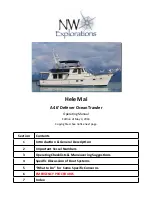
Page
103
(
143)
for mooring, towing or anchoring. Use sufficiently large fenders to prevent the boat
from chafing against the pier.
The eye in the bow is intended for use only with a sliding dock or trailer, not for
mooring or for any other operations that cause sideways stress. The bow deck also
features an eye of hardened steel for a locking chain. This eye may not be used for
any other purpose.
Mooring point strengths are shown in Figure 8. It is the responsibility of the owner or
the user to ensure that the mooring, towing and anchoring lines, ropes, chains and
anchors are suitable for the intended use and that the breaking strengths of the lines,
ropes and chains do not exceed 80% of the strength of the mooring point in question.
Loss of strength caused by wear and tear and/or knots in the lines and ropes must
also be taken into account.
When anchoring in a natural harbour, make sure the depth is sufficient by using an
echo sounder or a plumbline and lower the anchor far enough from the shore. A good
hold is achieved when the length of the anchor rope is 4
–5 times the depth. The hold
will be improved by releasing more rope. The hold improves significantly if the first 3
–
5 metres of the anchoring rope is chain or weighted rope. This also reduces wear
and tear on the rope.
WARNING
Never try to stop the boat by hand or place your hand or
foot between the boat and the pier, the shore or another
boat. Practise mooring in fair weather. Use engine power
sparingly but resolutely.
NB
When mooring the boat, consider potential changes in wind
direction, variations in water level, wake wash from other
boats, etc. For further information please consult your
insurance company and other sources of information.
When towing another boat, use a sufficiently strong, floating towing line. Start towing
gently, avoid sharp movements and do no not overload the engine. Beware of the
towing line becoming caught up in the propeller. When towing a small dinghy, adjust
the line length so that the dinghy rides on the downhill slope of your wake. In narrow
straits and high waves, bring the dinghy closer to the transom to stabilise its
movement. Fasten all equipment in the dinghy in place securely in case the dinghy
capsizes. When on the open sea, cover the dinghy to prevent flooding due to spray
and splashing from waves.
When towing or being towed, attach the towing line to the fixing points (cleats)
indicated in Figure 8.
WARNING
The towing line is under considerable stress during towing.
If the towing line snaps, the loose end could cause death.
Always use a sufficiently strong towing line and avoid being
directly in front of the towing line.
NB
Always use a very low speed when towing or being towed.
When towing a boat with a displacement hull, never exceed
the displacement speed of the boat being towed.
Содержание BUSTER SUPERMAGNUM
Страница 23: ...Sivu 23 143 LIITE 2 BUSTER SUPERMAGNUM YLEISJÄRJESTELYKUVA Buster SuperMagnum Selitteet sivulla 24 ...
Страница 27: ......
Страница 108: ...Page 108 143 APPENDIX 2 BUSTER SUPERMAGNUM GENERAL LAYOUT DRAWING Buster SuperMagnum See legend on page 109 ...
Страница 138: ...Seite 138 von 143 ANHANG 2 BUSTER SUPERMAGNUM ALLGEMEINER AUFBAU Buster SuperMagnum Siehe Legende auf Seite 139 ...
















































